[aviation news]
Question: I am a private pilot who spends a lot of time hanging out at the airport. Lately there has been discussion about the responsibility of a CFI during a noninstructional flight.
The CFI agreed to fly with a private pilot in the customer’s airplane after hours and off the clock for fun. They flew to a nontowered, slightly mountainous airport for kicks. It was a hot day, and the resulting density altitude situation combined with the short runway put them off the edge of the pavement into mud.
The aircraft was not damaged but was stuck there. It remained stuck there for a few days until it cooled down. Some of the pilots at the airport are saying the CFI was responsible for the aircraft getting stuck because the CFI is automatically the pilot in command (PIC) when they are on board an aircraft. Is this correct?
Answer: I think we hang out at the same airport. This discussion can get quite spirited. So many pilots can tell a story about a “buddy” who held a CFI ticket and was held responsible for an accident or incident, although at the time they weren’t providing instruction.
According to the FAA: “If a CFI is flying with a properly qualified private pilot and is not providing instruction, then the individual with operational control would be the pilot in command. The CFI is not automatically the pilot in command in all situations.”
(Puts on CFI cap) This is why the pretakeoff briefing needs to include language about which pilot—be it the ATP, private pilot, commercial pilot, or CFI—is going to be exercising PIC operational control during the flight. “My airplane, my controls” and “your airplane, your controls” mean just that.
Ask us anything you’ve ever wanted to know about aviation. Our experts in general aviation, flight training, aircraft, avionics, and more may attempt to answer in a future article. Email your questions to editorial@flyingmag.com.
Share this content:

